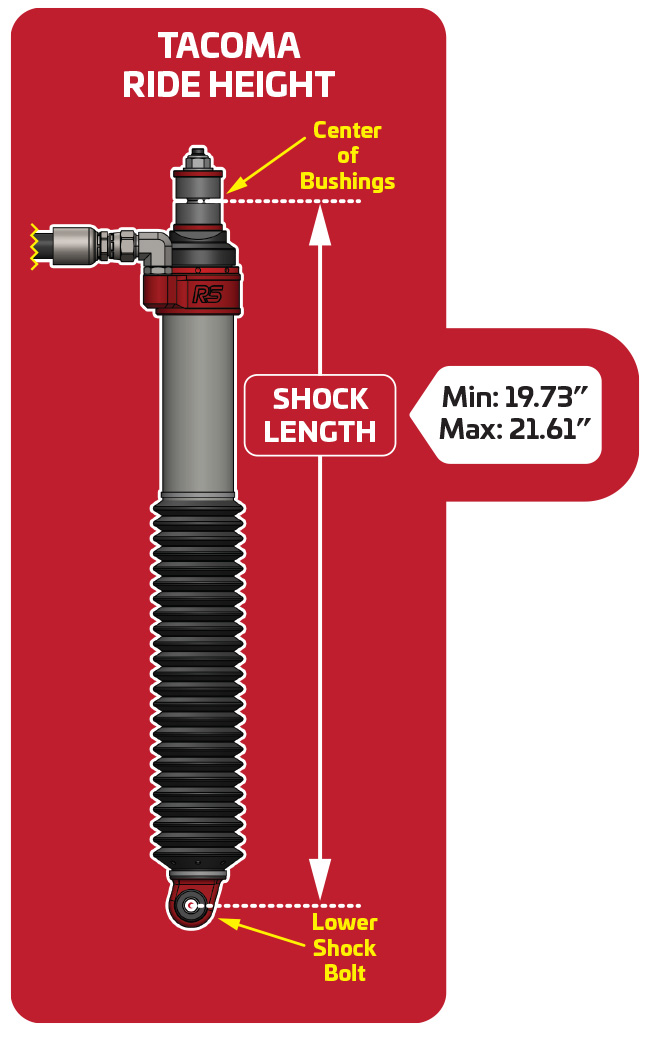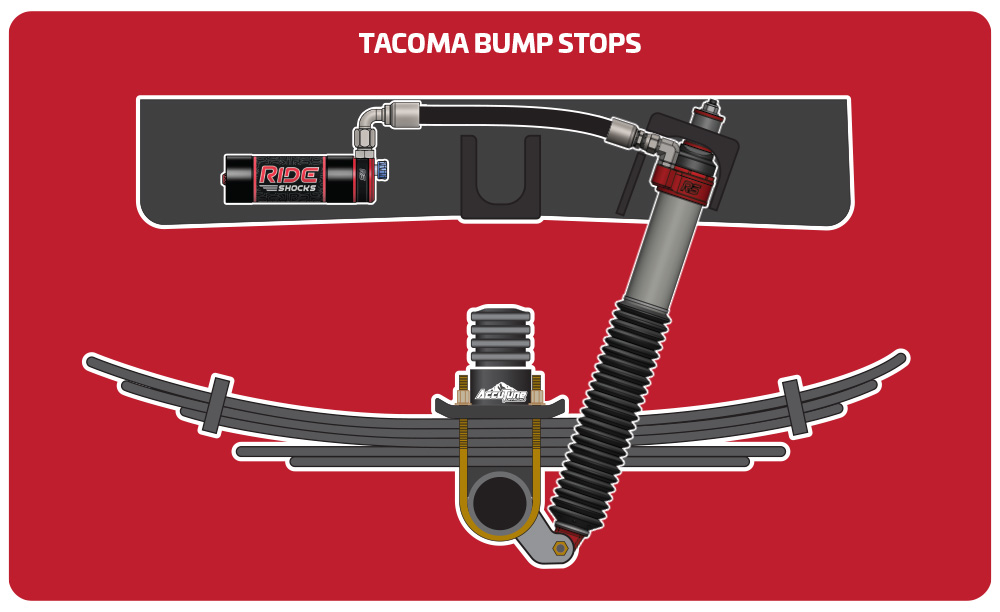
In this article we are going to go through a complete guide to setting up your new Ride Shocks on a 2005-2023 Toyota Tacoma.
Disclaimer: These instructions/measurements are in reference to Ride Shocks only and cannot be used to adjust other manufacturers shocks.
Front Suspension – Measuring Ride Height
Please note: Making adjustments to your coilovers should be done by an experienced mechanic. Ride Shocks is not responsible for any damages to you or your shocks. When making adjustments, be sure to remove the coil-over from the vehicle and use a spring compressor to remove tension. Once the tension is removed, you can adjust the pre-load ring.
Before: If you have not installed your coilovers yet, now is a good time to measure your stock ride height. You can compare this later on to see what your actual lift height is. Measuring current ride height can be done a few different ways, so choose the method that works best for you. First, you will need to pick the points of where to measure from. Examples of measurement locations would be: surface of the ground to center of differential skid plate or center of your wheel to the fender.

Front Ride Height
Getting the correct ride height is the first step in setting up your suspension. Preload is the initial (pre) tension (load) on your springs before carrying the weight of the vehicle. Each .25” of adjustment you make on the pre-load ring translates to approximately .50” of ride height change.
1. Install shocks. With the vehicle on level ground, settle suspension (drive back and forth 10 feet), ballpark toe setting if necessary.
2. Record height measurement.
3. Adjust preload with shocks removed from vehicle and using a spring compressor.
4. Repeat step 1 and re-check height when complete.
5. Repeat steps above as necessary until ride height is achieved.
6. Do not adjust preload with shocks installed on the vehicle.

Max Thread Length Above Preload Ring
Refer to the chart to correctly find the maximum .
• Never adjust pre-load with shocks on the vehicle.
• Use provided pre-load adjuster tool.
• DO NOT ADD additional pre-load past the max listed for your spring.
• Too much thread showing can cause coil bind, which will damage the spring and shock.

Too Much of a Good Thing. Don’t Over Do It!
Of course the main objective in adding pre-load is to increase the lift of the vehicle, but there can be a point where you added too much, even if you are still in range of the max exposed threads measurement.
The key is to make sure you still have sufficient down travel remaining when at ride height. Too little and you will run into handling issues and potentially damage suspension components.
Springs work in both extension and compression, so too much pre-load makes the shocks too harsh on compression and can lead to a bumpy ride. We look at suspension as a complete package and every piece of it has a purpose, as every component needs to work together in harmony.
Having too much pre-load could actually be a sign that you need to move up to the next available spring rate.
So after everything is accounted for, it is best to find that happy medium between ride height and ride quality.
Rear Suspension

Rear Ride Height
Setting rear ride height is something you have very little control over. You’re mostly going to be left with the card you’re dealt with when it comes to the rear end. Just make sure you’re in the Min/Max window and you should be good.
If you do find yourself below the Min measurement, then we suggest looking into alternative leaf springs for the rear of your Tacoma.
Another thing to note is that Ride Shocks for the rear of the Tacoma has a life height range of 1-2.5″ of lift. Do not attempt to run more or less lift than this or you could damage your shocks.

Bump Stops – Money Well Spent
For the rear suspension on your Tacoma, it’s important to have the correct length bump stops with your aftermarket shocks and leaf springs or you will risk damaging your shocks.
We recommend using the AccuTune Offroad U-Bolt Flip kit to ensure your rear suspension is providing the maximum suspension travel possible. Not only does this solve the issue with bump stop height requirements, but you will also gain ground clearance with a u-bolt flip and improve ride quality with a well designed bump stop.

Dual Piston Adjusters (DPA) – Settings


Low Speed Adjuster
What is Low Speed Compression? Low Speed Compression on a shock refers to the speed at which the shaft compresses into the shock body. A smoother, more gradual shock movement. Low speed compression occurs when a vehicle is cornering, braking/accelerating and driving over large rolling bumps.
When would I need to adjust Low Speed Compression? If you find the vehicle is having too much brake dive, feeling too bouncy or bottoming out on big rolling bumps, you should increase the Low Speed Compression on your DPA. Low speed adjustments on the reservoir are less noticeable than high speed adjustments.
High Speed Adjuster
What is High Speed Compression? High Speed Compression happens when the shock compresses very quickly. High speed compression occurs when hitting things like curbs, speed bumps, larger rocks, or washboard roads at higher speeds (although this is not exclusive to driving speeds). Even at 75 mph approaching a gradual hill is low speed compression, but if you hit a speed bump at just 15 mph, your shock must react very quickly. This is high speed compression.
When would I need to adjust High Speed Compression? If the suspension and tires are slamming through and bottoming out on hard hits you need to increase high speed compression. You should also increase it when adding weight to the vehicle or doing more aggressive offroad driving. High speed compression adjustments are more noticeable and can be the most useful adjustment on the shock.
12 Clicks of Adjustment
Ride Shocks come from the factory with both adjusters all the way decreased (open). This means they are at their softest setting. This allows you to have a full adjustment to increase the firmness of the ride. Only make adjustments by hand. Using a tool may damage adjusters.



Do you set the shock height in the front to 2.5.
Out of the box, Ride Shocks Coilover’s for a Tacoma will achieve about a 1.5-2″ lift over stock, as long as you have the correct weight range for those coilovers. Depending on your truck build, you may need to adjust preload a little bit to get the lift height you want. We do supply a spanner wrench with the coilover’s to help with adjustments.
Are these designed to work with your guys Deaver N98 pack? I have a set of foxs with your bump stop kit too but I’m looking to transition. I wasn’t sure if the rear shocks are designed to work best with stock leaf springs or better with aftermarket ones. I also want the truck leveled so will these shocks accommodate for that or will you guys recommend throwing on a stiffer spring, my truck is pretty much stock as far as weight except for the 33’s I have on, thanks.
Yes, our Tacoma rear shocks will work great with Deaver N98 leaf pack. As long as the leaf pack it’s adequate for the amount of added weight you have, the shock SKU: 525412789 would be perfect. If you had a different leaf pack with more weight, we have an option for that as well. The front coilovers are completely adjustable and will allow you to level the truck without needing different springs. For stock 3rd Gen Tacoma’s, these are the coilovers I would suggest for your Tacoma.
I recently adjusted preload but I think I went half inch more than recommended im now at 1.50″ measuring from thread. I have 600lb coil. would this affect the coil really bad ?
If you have 1.5″ of thread showing on the coilovers while maintaining our target 21″ shock length, there is a good chance you may need to have heavier rate coil springs. If your shock lengths are more than 21.25″ we would recommend reducing the amount of preload you have on the coilovers to provide better performance.
Can i rotate the reservoir on the ride shocks so its easy to turn the adjustment knobs or is there a tool to use?
We do not recommend changing the orientation of the reservoir from its current position.